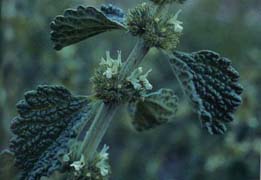The moist forest edge is representative of a disturbed clearing in the western hemlock zone. Although there are no remaining Tsuga heterophylla (Western hemlock) trees, the dominating presence of Polystichum munitum (Sword fern), mixed with Vaccinium parvifolium and Berberis (Mahonia) nervosa, on the forest floor tells of a prime habitat for growing hemlock and cedar.
Some traditional cultural uses for P. munitum include digging up the rhizome, peeling it, and baking it. The Quileutes of the outer coast found baked fern and salmon eggs a tasty combo. Fronds or leaves were used to line cooking fire pits, to lie under food on drying racks, and as a mattress material.
Bigleaf maple sends out aerial roots into the pads of epiphyte greenery and thereby aids the host tree.
Superstition in the UK holds that blackberries should not be picked after September 15th because the devil has claimed them, having left a mark on the leaves. This superstition is helpful because after this date wetter and cooler weather often allows the fruit to become infected by moulds such as Botrytis, which give the fruit an unpleasant flavor and may be toxic.
A strong decoction of Licorice Fern roots is most helpful in decreasing inflammatory and hypersensitivity states, including lung irritations, stomach and colon irritability, inflamed throat, mouth, and gums, and to counter cervix and prostate irritability. It is an alternative to antihistamines, which are efficient but have many side effects. Licorice Fern has no side effects, though it is less efficient. It can also be roasted or chewed as treatment. The juice is used for sore throats. Indigenous groups used the fern especially for chest complaints.
Blackberries and huckleberries were commonly made into jelly. Both berries provide numerous nutrients that many animals thrive on. Animals such as bears, squirrels, chipmunks, foxes, and skunks enjoy them. Huckleberry, which recides in the understory. Common understory associates that are also in our habitat include salal, western swordfern (Polystichum munitum), and deer fern.
Fruit of the evergreen huckleberry was traditionally used by many native peoples of the West Coast. The Capella Indians reportedly traveled up to 20 or 30 miles annually to harvest the fruit . Berries were eaten fresh, mashed, or dried and made into cakes. Preserved berries provided essential vitamin C during the winter months
